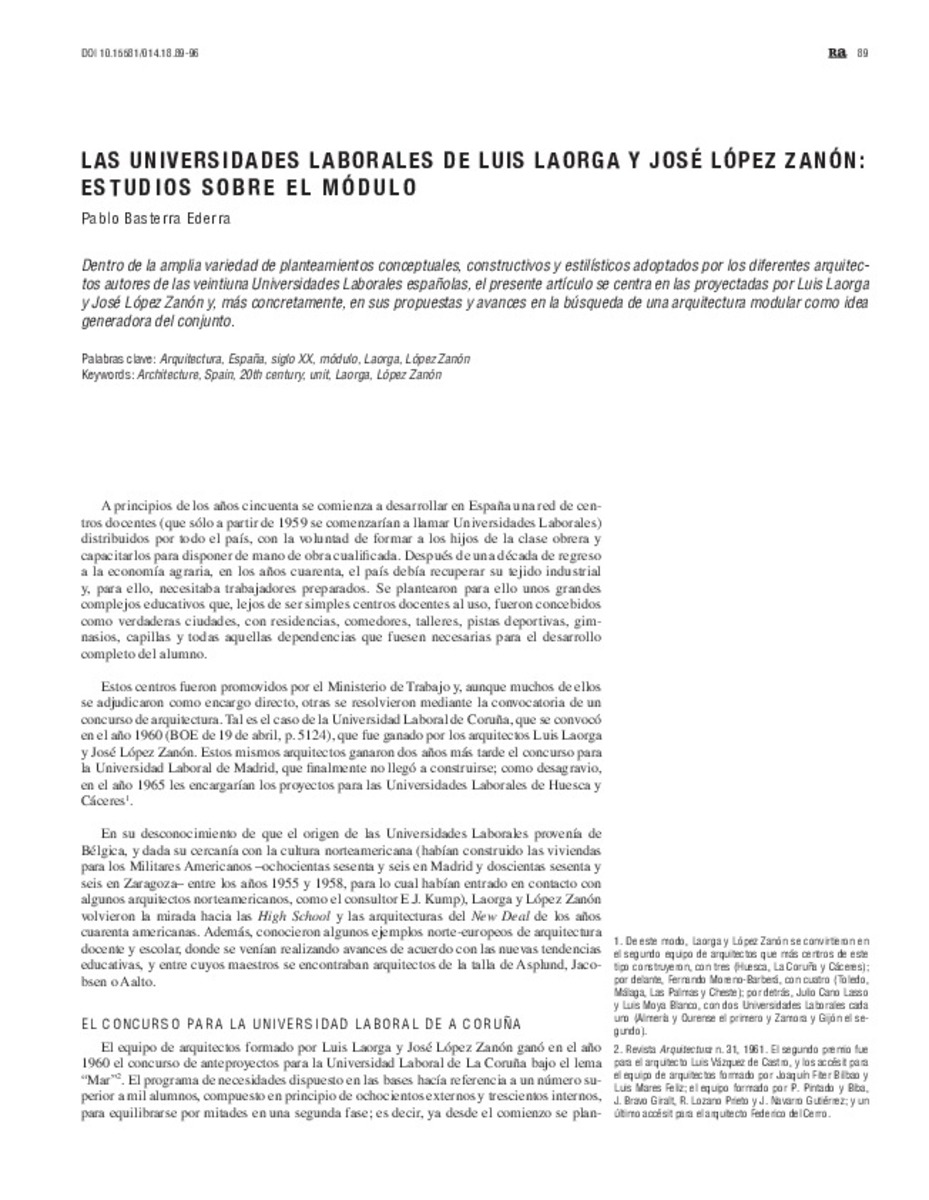Full metadata record
| DC Field | Value | Language |
|---|---|---|
| dc.creator | Basterra-Ederra, P. (Pablo) | - |
| dc.date.accessioned | 2018-01-16T07:44:15Z | - |
| dc.date.available | 2018-01-16T07:44:15Z | - |
| dc.date.issued | 2016 | - |
| dc.identifier.citation | Basterra-Ederra, P. (Pablo). "Las universidades laborales de Luis Laorga y José López Zanón: estudios sobre el módulo". Ra. Revista de Arquitectura. 18, 2016, 89 - 96 | es |
| dc.identifier.issn | 1138-5596 | - |
| dc.identifier.uri | https://hdl.handle.net/10171/45755 | - |
| dc.description.abstract | Dentro de la amplia variedad de planteamientos conceptuales, constructivos y estilísticos adoptados por los diferentes arquitectos autores de las veintiuna Universidades Laborales españolas, el presente artículo se centra en las proyectadas por Luis Laorga y José López Zanón y, más concretamente, en sus propuestas y avances en la búsqueda de una arquitectura modular como idea generadora del conjunto | - |
| dc.description.abstract | Between 1952 and 1976 a total of 21 vocational training institutions, known as workers’ universities, were built in Spain for workers’ children. These institutions, along with workers’ villages, constituted the most ambitious projects for compounds implemented in Spain (and Europe) in the twentieth century, in terms both of built area and the quality of the proposals involved. This article briefly describes the endeavour in general and subsequently focuses on the four workers’ universities, of which only three were actually built, designed by architects Luis Laorga and José López Zanón, for Corunna, Madrid, Huesca and Cáceres. Whilst a wide variety of approaches were adopted by the architects who authored the 21 workers’ universities built in Spain, Laorga and López Zanón’s hold particular interest due to the indivisible link between programme, form and construction. Laorga and López Zanón’s rigorous and pioneering study of the module as the key element in their designs stands out against the backdrop of the complete freedom afforded all the architects who authored these compounds. From the outset these two architects associated the conceit with the idea that informed the design, thereby contributing to the development of Spain's incipient precasting and prefabrication industries. Their ongoing pursuit of renewal is visible in the move from the fishbone enlargement at Corunna to the classroom-courtyard module used at Huesca and Cáceres and the concrete 'mushroom' devised for Madrid. That attitude was instrumental in broadening the variety of architectural schools that attempted to elbow their way into contemporary Spanish architecture, indisputably consolidating its late twentieth century brilliance. | - |
| dc.language.iso | spa | - |
| dc.publisher | Servicio de Publicaciones de la Universidad de Navarra | - |
| dc.rights | info:eu-repo/semantics/openAccess | - |
| dc.subject | Arquitectura | - |
| dc.subject | España | - |
| dc.subject | siglo XX | - |
| dc.subject | módulo | - |
| dc.subject | Laorga | - |
| dc.subject | López Zanón | - |
| dc.subject | Architecture | - |
| dc.subject | Spain | - |
| dc.subject | 20th century | - |
| dc.subject | unit | - |
| dc.subject | Laorga | - |
| dc.subject | López Zanón | - |
| dc.title | Las universidades laborales de Luis Laorga y José López Zanón: estudios sobre el módulo | - |
| dc.title.alternative | Worker's universities designed by Luis Laorga and José López Zanón: the module as an object of study | - |
| dc.type | info:eu-repo/semantics/article | - |
| dc.identifier.doi | 10.15581/014.18.89-96 | - |
| dadun.citation.endingPage | 96 | - |
| dadun.citation.publicationName | Ra. Revista de Arquitectura | - |
| dadun.citation.startingPage | 89 | - |
| dadun.citation.volume | 18 | - |
| dc.date.updated | 2018-01-16T07:44:15Z | - |
| dc.description.version | Peer Reviewed | - |
Files in This Item:
Statistics and impact
Items in Dadun are protected by copyright, with all rights reserved, unless otherwise indicated.






